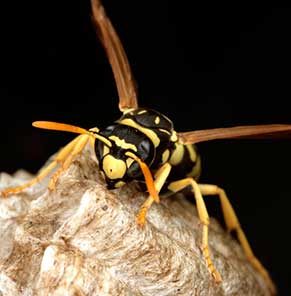Bees or Yellow Jackets? How to Tell the Difference
 What are those yellow-striped bugs flying around your house and making loud buzzing noises? Are they bees or yellow jackets? How can you tell which bug is which? Here’s important information about bees and yellow jackets to help you spot the differences between the two insects.
What are those yellow-striped bugs flying around your house and making loud buzzing noises? Are they bees or yellow jackets? How can you tell which bug is which? Here’s important information about bees and yellow jackets to help you spot the differences between the two insects.
Bees Want Pollen
There are numerous species of bees in the U.S., including 49 species of bumblebees. Some bees make a lot of noise when moving around and inside of flowers, but the buzzing noises aren’t warnings. For example, the bumblebee’s fast and loud movements inside a flower cause the pollen to sonically move from the blossom to the bumblebee’s legs.
Species of bees that live in the U.S. include the following:
- Honeybee
- Bumblebee
- Carpenter bee
- Mason bee
- Leafcutter bee
- Blueberry bee
- Squash bee
- Sweat bee
All of the above bees are important pollinators of produce, flowers, and native plants. Bees are not aggressive, but bees will sting if they’re crushed, trapped, or attacked. In some bee species, only one gender can sting humans. For example, male carpenter bees are often territorial and aggressive, but they can’t sting you.
Bees may be striped in yellow, brown, or black. Some bees, like mason, blueberry, and leafcutter bees, are colored gray, blue, or black with few or no stripes. Bee’s waists are generally thick where their upper and lower body parts merge.
Bees have small hairs on their bodies and on their dark legs. Leg hairs may be yellow, brown, white, gray, or black. Most bees have pollen baskets on their feet to carry the particles from flower to flower. With these features, the bee species pollinate the fruits, vegetables, and ornamental plants that humans enjoy.
Honeybees are responsible for pollinating up to one-third of all foods eaten by people in the U.S., yet honeybees are on the decline, including in Virginia. State beekeepers report losing 60 percent of their bees in 2018. Agricultural officials urge Virginia residents to help all bees by tolerating their presence when possible.
Yellow Jackets Are Insect Eaters
Yellow jackets are actually a type of wasp. The yellow jacket is often confused with honeybees, since both insects are around the same size, and both insects have yellow and dark striped bodies. Yellow jackets are common in the southeastern U.S., but there are species of yellow jackets found throughout the world.
Yellow jackets are social insects that build extensive nests to house their colonies of thousands of individuals. In the state of Alabama, authorities recently discovered that yellow jackets are creating nests as large as cars.
Large nests near human habitations are a problem. Yellow jackets are territorial and aggressive; so many individual yellow jackets may attack a person who accidentally stumbles onto or within a few feet of a yellow jacket nest. Unlike bees, who each only have one stinger, yellow jackets can sting repeatedly with no harm to the stinging insects themselves.
The yellow jacket’s main diet is other insects, but yellow jackets enjoy foraging on human foods like meat and sugary snacks. You’ll rarely or never see a honeybee swarming around an open soda can or half-eaten ham sandwich, but yellow jackets love to hover and consume your picnic menu items.
Bees generally have fuzzy lower bodies, but yellow jackets have shinier lower bodies without any long hairs. Legs of the yellow jacket are thin and yellowish with no visible pollen-collecting hairs. The waist of the yellow jacket is thin and wasp-like.
A stinging yellow jacket swarm is hazardous for adults, kids, and pets. Contact a pest management professional to handle the job of eradicating dangerous and aggressive yellow jackets from your yard.
Seek help with the removal of troublesome yellow jacket nests in Virginia by contacting PermaTreat Pest and Termite Control as soon as possible.


































































